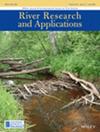Wood you believe it? Experimental addition of nonnative wood enhances instream habitat for native dryland fishes
IF 1.9
4区 环境科学与生态学
Q4 ENVIRONMENTAL SCIENCES
引用次数: 0
Abstract
Flow alteration and riparian vegetation encroachment are causing habitat simplification with severe consequences for native fishes. To assess the effectiveness of enhancing simplified habitat in a large dryland river, we experimentally added invasive wood at 19 paired treatment and reference (no wood added) subreaches (50–100 m) within the main channel of the San Juan River. Using a before‐after‐control‐impact design, we sampled fishes and macroinvertebrates, and quantified habitat complexity. After wood addition, total native fish densities were 2.2× higher in treatments compared with references, whereas total nonnative fish densities exhibited no response. Macroinvertebrate densities were 6.8× higher, and habitat complexity increased in treatments. Counts of geomorphic features in treatments increased from 1 to a maximum of 11 following wood addition, while the number of features in references remained unchanged. Wood addition has potential to instigate natural riverine processes, ultimately enhancing native fish habitat by increasing macroinvertebrate densities and habitat complexity in dryland rivers. Water overallocation and increasing aridity will continue to challenge efforts to improve habitat conditions with environmental flows alone, and managers might consider integrating non‐flow alternatives like addition of abundant, invasive wood to reduce habitat simplification.木头你相信吗?试验性添加非本地木材可改善本地旱地鱼类的河内栖息地
水流的改变和河岸植被的侵占正在导致栖息地的简化,从而给本地鱼类带来严重后果。为了评估在一条大型旱地河流中加强简化栖息地的效果,我们在圣胡安河主河道内的 19 个配对处理和参照(未添加木材)子河段(50-100 米)试验性地添加了入侵木材。我们采用控制影响前后的设计,对鱼类和大型无脊椎动物进行了采样,并对栖息地的复杂性进行了量化。添加木材后,处理区的本地鱼类总密度比参照区高 2.2 倍,而非本地鱼类总密度则没有变化。处理区的大型无脊椎动物密度增加了 6.8 倍,栖息地的复杂性也有所增加。添加木材后,处理区的地貌特征数量从 1 个增加到最多 11 个,而参照区的地貌特征数量保持不变。木材添加具有促进河流自然进程的潜力,通过增加旱地河流中大型无脊椎动物的密度和栖息地的复杂性,最终改善本地鱼类的栖息地。水量总体分配和日益干旱将继续挑战仅靠环境流量来改善栖息地条件的努力,管理者可考虑整合非流量替代方案,如添加丰富的入侵性木材,以减少栖息地的简化。
本文章由计算机程序翻译,如有差异,请以英文原文为准。
求助全文
约1分钟内获得全文
求助全文
来源期刊

River Research and Applications
环境科学-环境科学
CiteScore
4.60
自引率
9.10%
发文量
158
审稿时长
6 months
期刊介绍:
River Research and Applications , previously published as Regulated Rivers: Research and Management (1987-2001), is an international journal dedicated to the promotion of basic and applied scientific research on rivers. The journal publishes original scientific and technical papers on biological, ecological, geomorphological, hydrological, engineering and geographical aspects related to rivers in both the developed and developing world. Papers showing how basic studies and new science can be of use in applied problems associated with river management, regulation and restoration are encouraged as is interdisciplinary research concerned directly or indirectly with river management problems.
 求助内容:
求助内容: 应助结果提醒方式:
应助结果提醒方式:


